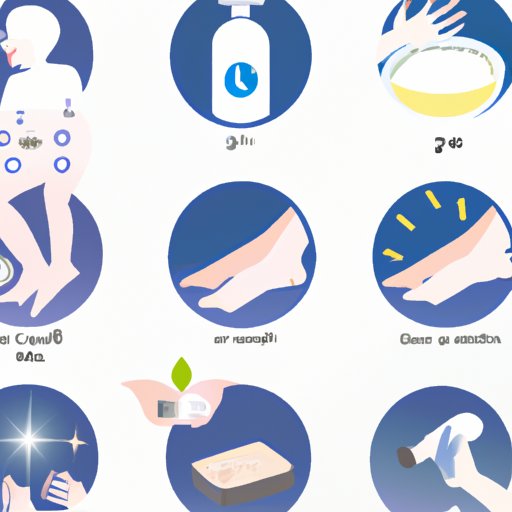Introduction
Psoriasis is a chronic skin condition that affects millions of people around the world. It is characterized by red, scaly patches on the skin that can be itchy, painful, and uncomfortable. Although there is no cure for psoriasis, there are ways to manage the symptoms and reduce flare-ups. This article will provide an overview of how to care for psoriasis at home.
Follow a Healthy Diet
Eating a balanced diet is key to managing psoriasis and reducing flare-ups. Fruits and vegetables are especially important, as they contain antioxidants and vitamins that can help keep skin healthy. Incorporating lean proteins, healthy fats, and whole grains into your diet can also help reduce inflammation and improve overall health.
If you’re not sure how to start, try adding a few servings of fruits and vegetables to each meal. You can also incorporate more plant-based proteins into your diet, such as nuts, legumes, and tofu. Eating a variety of nutrient-dense foods can help keep your body in balance and ward off flare-ups.
Take Short, Warm Baths
Soaking in lukewarm water can help soothe itchy, inflamed skin. However, it is important to limit your baths to no more than 15 minutes, as longer exposure to water can dry out the skin. After your bath, gently pat your skin dry with a soft towel and apply a moisturizer within three minutes of getting out of the bath to lock in moisture.
Adding oatmeal or Epsom salts to your bath can also help reduce itching and inflammation. If you have severe psoriasis, you may want to consider using a topical steroid or other medication in the bath.
Apply Moisturizers
Moisturizing your skin is essential for managing psoriasis. There are many different types of ointments, creams, and lotions available to choose from. Your doctor can recommend a product that is appropriate for your skin type. Make sure to read the instructions carefully before applying any product to your skin.
It is important to apply moisturizers several times a day to keep skin hydrated. Pay attention to areas that are prone to dryness and flaking, such as elbows, knees, hands, and feet. Regularly applying a moisturizer can help reduce itching, flaking, and discomfort.
Avoid Triggers
Certain triggers can cause psoriasis flares. Common triggers include stress, smoking, alcohol, weather changes, and certain medications. Identifying your triggers and avoiding them as much as possible can help reduce the severity and frequency of your psoriasis flare-ups.
If you’re not sure what your triggers are, try keeping a journal to track your symptoms. Note when your symptoms worsen and what activities or situations preceded the flare-up. This can help you identify potential triggers and create strategies for avoiding them in the future.
Exercise Regularly
Regular physical activity can help reduce stress, boost immunity, and improve overall health. Exercise can also help manage psoriasis symptoms. Low-impact activities, such as walking, swimming, and yoga, can help reduce inflammation and improve circulation.
To get started, try to incorporate 30 minutes of exercise into your daily routine. Choose activities that you enjoy and make time for them. Exercise can help reduce stress and improve your quality of life.
Conclusion
Although there is no cure for psoriasis, there are ways to manage the symptoms and reduce flare-ups. Eating a healthy diet, taking short baths in lukewarm water, applying moisturizers, avoiding potential triggers, and exercising regularly can all help keep your psoriasis under control. With the right care and lifestyle changes, you can reduce the severity and frequency of your psoriasis flare-ups.
(Note: Is this article not meeting your expectations? Do you have knowledge or insights to share? Unlock new opportunities and expand your reach by joining our authors team. Click Registration to join us and share your expertise with our readers.)
